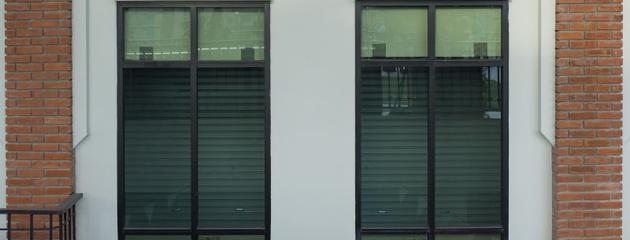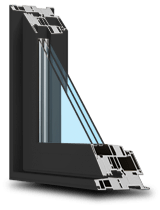Which Window Types Will Be Popular This Year in Ottawa?

Key Takeaways
- Top window trends in Ottawa for 2025 include black frames, large picture windows, and minimalist flush-frame designs — all combining modern aesthetics with climate-conscious functionality.
- Ottawa’s cold weather demands high-performing windows with low U-factors, triple-pane glass, Low-E coatings, and inert gas fills for insulation and condensation control.
- Vinyl remains the most popular material for its durability, affordability, and resistance to moisture, while wood and aluminum serve niche aesthetic and architectural needs.
- Energy efficiency is a major priority, with Energy Star–certified windows helping reduce heating costs and improve home comfort year-round.
- Casement windows offer superior sealing and ventilation compared to double-hung styles, making them ideal for Ottawa’s harsh winters.
- Thanks to UV-resistant coatings and widespread aesthetic appeal, black window frames dominate custom builds and renovations.
- Common mistakes to avoid: undervaluing insulation performance, choosing the wrong climate material, and compromising professional installation quality.
What are the top window styles trending in Ottawa right now?
Modern Ottawa homes are embracing bold yet streamlined window designs, balancing aesthetics with practicality. The architectural tone of 2025 leans toward clean lines, large panes, and sleek profiles — ideals that resonate deeply with both new builds and renovations.
Black Window Frames: A Statement in Contrast
Homeowners are gravitating towards black window frames, a trend that adds a striking contrast to lighter exteriors. Inspired by European modernism, black frames work seamlessly with both contemporary and heritage-style homes. Their popularity lies not only in their visual appeal but also in their versatility across materials, particularly vinyl.
These dark frames define a window’s perimeter sharply, adding depth and drama. According to recent installation data from Canadian Choice Windows & Doors, black-framed windows now account for over 30% of new installations across Ottawa, especially in urban infill and suburban custom homes.
Large Picture Windows: Bringing the Outside In
Minimalist interior design and a desire for more natural light have pushed large picture windows to the forefront. These windows, often unbroken by grilles or muntins, provide expansive views and maximize sunlight, a boon during long winters. Picture windows are usually paired with fixed panes or casement units to balance beauty with functionality.
Architects favour them in open-concept living spaces, where daylighting reduces the need for artificial light, improving mood and energy usage.
Minimalist and Flush-Frame Styles
Flush frames and minimalist window styles are increasingly popular in Scandinavian- and Japanese-inspired interiors. These frames emphasize clean geometry and align well with ultra-modern homes. They also enhance thermal efficiency by reducing exposed frame area, a practical benefit during freezing months.
What’s the takeaway? Homeowners aren’t just picking windows for their looks. There’s a precise alignment with climate-conscious design, architectural context, and material innovation.

How does Ottawa’s weather influence the best window choice?
With temperatures frequently dropping below -20°C and humidity levels fluctuating wildly, poorly designed windows can be both an energy sink and a source of discomfort.
Insulation and Thermal Resistance
Windows must provide strong insulation to retain winter heat and reduce summer cooling demands. This performance is typically measured by U-factor (lower is better) and R-value (higher is better). Energy Star recommends U-factors below 1.22 W/m²·K in the climate zone for windows.
Triple-pane glass, low-E coatings, and insulated frames are becoming the norm.
Condensation Resistance and Moisture Control
Another key issue is condensation, especially where warm indoor air meets frigid glass. Not only is this a visibility issue, but it can also cause mould and rot. Modern window systems include warm-edge spacers, inert gas fills (argon or krypton), and thermally broken frames to combat this.
Which window materials are ideal?
Choosing the right window material in 2025 means balancing budget, durability, and climate adaptability. Each option offers distinct advantages and potential trade-offs.
| Material | Durability | Insulation Value | Climate Suitability |
|---|---|---|---|
| Vinyl | High | Good | Excellent for cold climates |
| Wood | Moderate (needs upkeep) | Good | Great for heritage homes |
| Aluminum | Moderate (cold bridge risk) | Fair | Better in commercial settings |
Vinyl
Vinyl remains the most popular choice in Ottawa, especially for homeowners seeking a mix of affordability and thermal performance. It doesn’t warp, resists moisture, and offers sound insulation. Modern vinyl windows are reinforced for longevity and are often used in casement and slider configurations.
Wood
While beautiful and naturally insulating, wood requires maintenance to prevent rot or insect damage. It’s ideal for heritage properties or high-end custom homes where aesthetics matter more than cost. Modern wood windows often come clad in aluminum or vinyl exteriors to boost their lifespan.
Aluminum
Aluminum is sleek and strong but conducts heat poorly unless thermally broken. While it’s still used in large commercial or mixed-use buildings, it's rarely chosen for residential homes due to its poor cold-weather performance.
What’s clear is that material matters as much as style. In 2025, informed homeowners combine energy data with aesthetics to make the best long-term choice.

What are the most energy-efficient window options available this season?
Energy efficiency isn’t a luxury — it’s a necessity. With rising utility costs and a climate that demands year-round temperature regulation, homeowners increasingly prioritize window systems that maximize insulation and minimize heat transfer.
Double- and Triple-Pane Glass
Double-pane windows were once the standard, but triple-pane glass has emerged as the gold standard in energy-efficient design. It offers superior thermal insulation, noise reduction, and condensation resistance. Each pane creates an additional barrier against heat loss.
Double-pane: Still common, typically filled with argon gas.
Triple-pane: Ideal for Ottawa, especially when combined with low-E coatings.
Low-E Coatings and Gas Fills
Low-emissivity (Low-E) coatings are thin metallic layers applied to window glass. They reflect heat into the home in winter and block UV rays in summer. Most high-efficiency windows today include multiple Low-E layers, especially on north- and west-facing facades.
Inert gases like argon and krypton are injected between panes to reduce heat transfer. Krypton offers better insulation but at a higher cost, and is often used in compact triple-pane designs.
In short, energy efficiency is the result of technology (like Low-E and gas fills), structural design (triple-pane), and wise consumer choices backed by rebates and expert advice.
How do double-hung and casement windows compare for homes?
Style and functionality can sometimes be at odds, but when it comes to double-hung vs. casement windows, each has distinct pros and cons.
| Feature | Double-Hung | Casement |
|---|---|---|
| Appearance | Traditional, balanced | Sleek, modern |
| Airflow Control | Moderate, opens top or bottom | Excellent, opens fully outward |
| Energy Efficiency | Lower (more potential for leakage) | Higher (better sealing) |
| Maintenance | Easier to clean (tilt-in sashes) | More moving parts to maintain |
| Cost | Generally less expensive | Slightly higher upfront |
Casement windows are often favoured in modern Ottawa builds for their energy efficiency and full-swing opening mechanism. Double-hung styles remain popular in traditional homes or upper-floor bedrooms, where easy cleaning is a priority.
The decision often comes down to aesthetic harmony with the house and desired energy performance. Casement models typically provide superior air sealing and less draft potential for colder climates.
Are black window frames still in style in Ottawa?
In a word: absolutely. Black window frames remain one of Ottawa's residential architecture's most durable design trends. However, their continued popularity is now matched by more innovative manufacturing and thoughtful homeowner concerns.
Visual Appeal and Versatility
Black frames serve as a neutral architectural anchor. Whether set against light siding, brick, or stone, they create definition and depth. This year, designers are pairing black frames with natural wood interiors, mixed textures, and matte finishes for a timeless yet current look.
Concerns Around Heat and Fading
A common myth is that black windows absorb too much heat. While this is partially true — black absorbs more sunlight — modern finishes use UV-resistant, powder-coated materials that mitigate fading and warping.
Tony Wong explains:
“The concerns are valid, but technology has caught up. We use coatings specifically rated for solar exposure, and fading hasn’t been an issue for years.”
Local Design Momentum
Across Ottawa suburbs like Barrhaven and Kanata, recent builds and renos feature prominent black frames. Builders report they are now included in over half of all custom projects, with homeowners citing modern appeal and resale value.
So yes, black windows are not just in style, they’re becoming a design standard. They offer bold aesthetics, high contrast, and — when manufactured properly — stand up to Ottawa’s harsh winters and summer heat.

What role do Energy Star ratings play when choosing windows?
What Energy Star Ratings Measure
Energy Star windows are evaluated based on the U-factor, Solar Heat Gain Coefficient (SHGC), visible transmittance, and air leakage. For the Zone 2 region:
- U-factor should be ≤ 1.22 W/m²·K
- SHGC should be balanced based on sun exposure
- Triple glazing and Low-E coatings are strongly encouraged
Decoding the Label
The Canadian Energy Star label displays:
- Climate zone compatibility
- Certification number
- Manufacturer and product series
Why It Matters for Ottawa
Energy Star windows in Ottawa can reduce heating costs by up to 15% annually. According to NRCan, replacing single-pane windows with certified products can save the average homeowner $100–$500 per year, depending on home size.
In short, Energy Star isn't just a sticker — it’s a government-backed benchmark of thermal performance, trustworthiness, and long-term value.
What mistakes should I avoid when choosing new windows?
Even well-meaning homeowners can make costly missteps during window replacement. These aren’t just aesthetic issues — they can lead to energy loss, condensation, and future repair bills.
Mistake 1: Ignoring Insulation Values
Selecting windows without understanding the U-factor or glazing options leads to poor performance. A beautiful window that leaks heat will quickly cost more in energy bills than it saved upfront.
Mistake 2: Choosing the Wrong Material
Wood looks great, but may not suit every home or budget. Aluminum is sleek, but not ideal for winters. Consider your neighbourhood norms, heating patterns, and exposure to wind when picking between vinyl or composite.
Mistake 3: Prioritizing Price Over Installation Quality
Windows are only as good as their installation. Poor sealing, improper flashing, or rushed work can undo even the best triple-glazed unit. Always hire a certified local installer — and ask for references.
What’s the smartest window choice for Ottawa this year?
Weather in Ottawa’s architecture and rebate landscape all point toward a specific type of window: one that’s insulated, modern, and resilient. Let’s break down the top picks.
| Feature | Best Recommendation |
|---|---|
| Style | Casement + Picture Combo |
| Material | Premium vinyl |
| Glazing | Triple-pane with Low-E coatings |
| Frame Colour | Matte black (UV-treated) |
| Certification | Energy Star (Zone 2 compliant) |
Want to explore top-rated options? Book a free consultation with Canadian Choice Windows & Doors and make your 2025 renovation smart, stylish, and sustainable.
Book a FREE Consultation Book a FREE Consultation
1000’s of Colours & Textured Finishes
Transform your home from ordinary to extraordinary with our new coloured and non-glare textured finishes. Available in a wide array of colours as well as custom matched colours for your very own personalized design.
Our Most Popular Replacement Window Colours:









